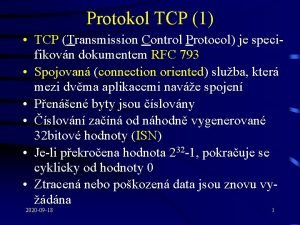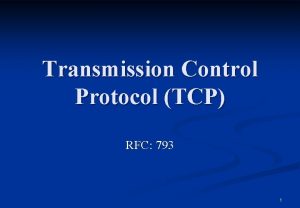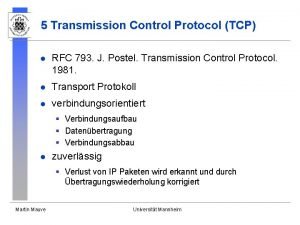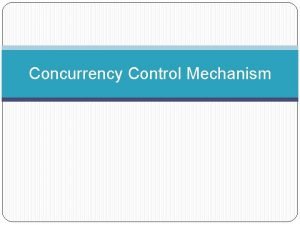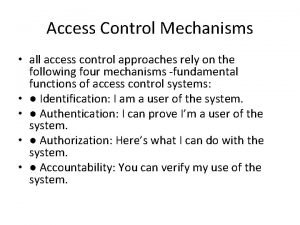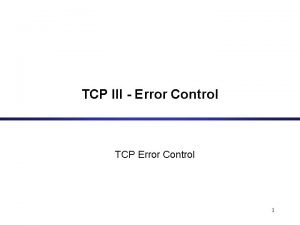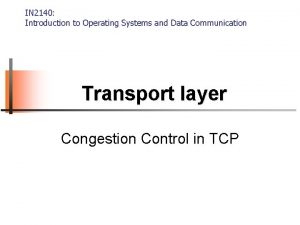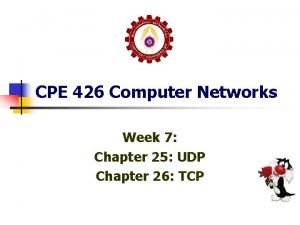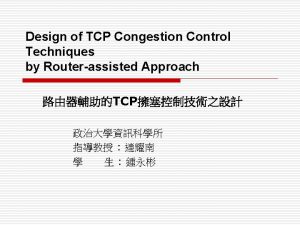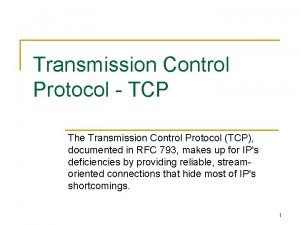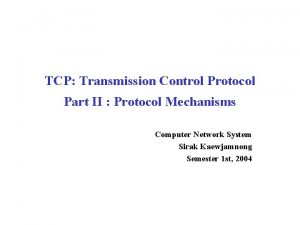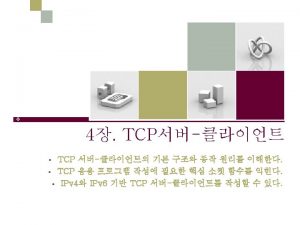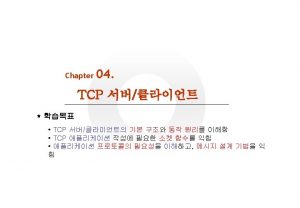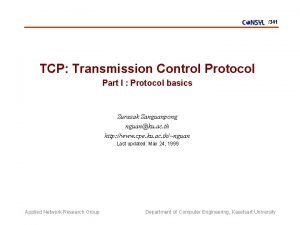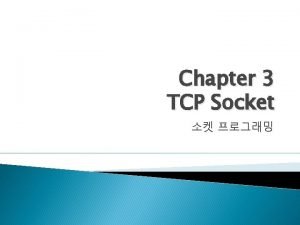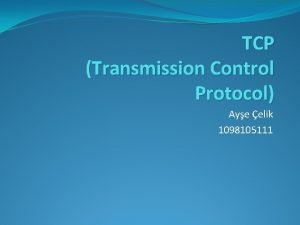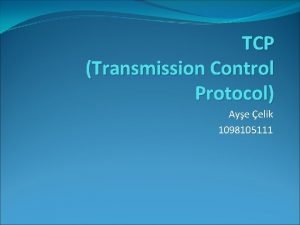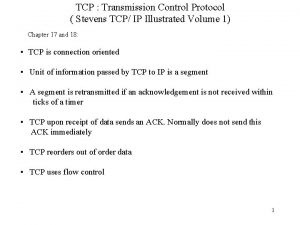TCP Transmission Control Protocol Part II Protocol Mechanisms
















- Slides: 16

TCP: Transmission Control Protocol Part II : Protocol Mechanisms Computer Network System Sirak Kaewjamnong Semester 1 st, 2004

Agenda • • • TCP timers Nagle’s algorithm Silly Window Syndrome Delay acknowledgment Congestion control 2

TCP timers • Retransmission timer- expecting acknowledgment time • Persist timer- keeps window size information flowing • Keepalive timer- detect idle connection due to crashing or reboot • 2 MSL- duration of TIME_WAIT state 3

Retransmission timer • Fixed time-out is unacceptable because: • impossible to support both LAN/WAN • if too short, retransmission problem • if too long, decrease throughput • TCP uses adaptive retransmission timer • learning by measurement of round-trip time (RTT) experiences • track these changes to adjust its time-out 4

Retransmission timer: backoff • RTO changed in exponential like 1, 3, 6, 12, 24, 48, 64 secs • RTO is doubled for each retransmission with an upper limit of 64 secs • this called exponential backoff • retry retransmission until 9 minutes, then reset 5

Retransmission timer: RTO Jacobson’s retransmission time-out (RTO): RTO = R+4 D D D+h(|Err|-D) R R+g. ERR Err =M-R • • • R = smoothed RTT (estimator of the average) D = smoothed mean deviation Err = diff between last RTT and current RTT estimator g = gain; normally set to 0. 125 h = deviation gain; normally set to 0. 25 6

Retransmission timer: Karn’s algo. • Consider a case : a packet is transmitted, a time out occurs, the packet is retransmitted, an ACK is received. Is ACK for the first or the second? • Karn’s algorithm specifies when time-out, do not update the RTT estimator • new RTO is calculated only for a not-retransmitted segment 7

Persist timer • one end advertise window=0 to stop transferring • later, it send a segment with window advertisement, but a segment is lost! • if no any mechanism, transferring is stopped • other end set a persist timer ~500 ms to ask for a new window updated • send 1 byte of data to probe 8

Persist timer: Silly Window Syndrome • small amount of data are exchanged, instead of full -sized segments • cause: – receiver advertise small windows, instead of waiting for a bigger one – sender transmit small chunk, instead of waiting for a bigger one • solve: – receiver must not advertise small windows – sender try to transmit a full-sized segment of a half of window advertisement buffer 9

Keepalive timer • periodically sent TCP segment to confirm the connection • if no acknowledge after a number of retries, the connection is reset. • keep-alive segment should not be passed to the application layer 10

Delayed Acknowledgment • not send ACK immediately after receiving data, • delayed ACK typically. 2 ms, then send win size, ACK and echo data together (piggyback) • most implementations use a 200 ms delay • Host requirements RFC specifies delay ACK should be implemented with max 500 ms delay 11

Nagel’s algorithm • RFC 896: prevent sending of small segments which cause congestion in WAN • TCP can have only one outstanding un. Ack small segment. Can’t send more until Ack arrives • this collects more data before next sending • self-clocking : go as fast as the small latency • not for applications that send small data chunks e. g. X windows, a mouse click has to be sent as real time as possible 12

Congestion control • congestion : outgoing way has less capacity to send data • faster LAN to slower WAN • multiple input go to router’s less capacity output • What’s then? -packet dropped; if more data sent, more bad situation • How does a host know that lost packets are from congestion or damage packet? • No way!, but our assumption is, lost packets cause by damage is very small (<1%) • We assume that the loss come from congestion! 13

Congestion control • How to solve congestion? • not easy to direct solve, but we can avoid • Use Jacobson’s Congestion Avoidance and Control Algorithm • Jacobson’s algorithm: 2 parts • slow start • congestion avoidance 14

Slow start • Slow start: – set congestion window (cwnd) to one segment – data sent no more than cwnd and receiver’s windows advertisement – double cwnd each sending until reach receiver’s windows advertisement – if congestion occurs, perform slow start with congestion avoidance 15

Slow start with congestion avoidance • new slow start: – slow start until cwnd reaches a half of old cwnd at congestion point – perform congestion avoidance: increasing cwnd by 1/cwnd for each ack – lead to linear increasing of cwnd 16
 Tcp (transmission control protocol) to protokół
Tcp (transmission control protocol) to protokół 4-way handshake
4-way handshake Transmission control protocol
Transmission control protocol Rfc tcp protocol
Rfc tcp protocol Arp protocol in tcp/ip
Arp protocol in tcp/ip Tcp verbindungsaufbau
Tcp verbindungsaufbau Portal circulation
Portal circulation Concurrency control mechanism
Concurrency control mechanism Since the bastion host stands as a sole defender
Since the bastion host stands as a sole defender What is social control
What is social control Quality control mechanisms
Quality control mechanisms Tcp
Tcp Tcp congestion control
Tcp congestion control Tcp congestion control
Tcp congestion control Tcp flow control
Tcp flow control Cpe 426
Cpe 426 Tcp flow control
Tcp flow control

